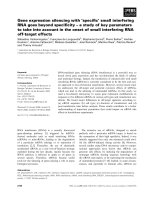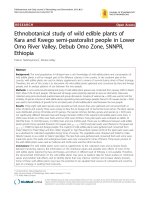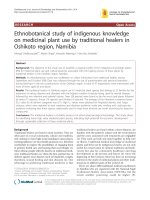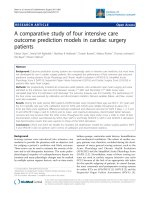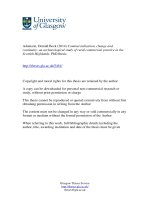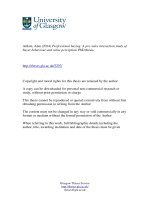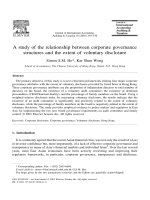Morphological diversity and ethnobotanical study of ENSET (ensete ventricosum (welw ) cheesman) landraces in kebena, cheha and ezha woredas, gurage zone, SPNNRS, ethiopia
Bạn đang xem bản rút gọn của tài liệu. Xem và tải ngay bản đầy đủ của tài liệu tại đây (1.98 MB, 85 trang )
Morphological Diversity and Ethnobotanical Study of
ENSET(Ensete ventricosum (Welw.) Cheesman) Landraces in
Kebena, Cheha and Ezha Woredas, Gurage Zone, SPNNRS,
Ethiopia
Adanech Jarso Mojo
Addis Ababa University
Addis Ababa, Ethiopia
June, 2017
Morphological Diversity and Ethnobotanical Study of ENSET (Ensete ventricosum
(Welw.) Cheesman )Landraces in Kebena, Cheha and Ezha Woredas, Gurage
Zone, SPNNRS, Ethiopia
Adanech Jarso Mojo
A Thesis Submitted to
The Department of plant Biology and Biodiversity Management
Presented in Partial Fulfilment of the Requirements for the Degree of Master of
Science in Plant Biology and Biodiversity Management
Addis Ababa University
Addis Ababa, Ethiopia
June, 2017
ADDIS ABABA UNIVERSITY
GRADUATE PROGRAMMES
This is to certify that the Thesis prepared by Adanech Jarso Mojo, entitled:
Morphological diversity and Ethnobotanical Study of
ENSET
(Ensete ventricosum
(Welw.) Cheesman) Landrace in Kebena, Cheha and Ezha Woredas, Gurage zone,
Ethiopia and Submitted in Partial fulfillment of the Requirements for the Degree of
Master of Science (Plant Biology and Biodiversity Management)complies with the
regulations of the University and meets the accepted standards with respect to
originality and quality.
Signed by Examining Board.
Name
Signature
1. Prof.Zemede Asfaw (Examiner)
2. prof. Sileshi Nemomsa (Examiner)
(Examiner)
3. Prof. Sebsebe Demissew (Advisor)
4. Dr. Tigist Wondimu (Advisor)
5. Dr. Ermias
(Chairman)
ii
Date
Abstract
Morphological Diversity and Ethnobotanical Study of ENSET (Ensete ventricosum
(Welw.)Cheesman ) landraces in Kebena Cheha and Ezha Woredas, Gurage Zone, Ethiopia
Adanech Jarso Mojo, MSc Thesis.
Addis Ababa University, May 2017
Ensete ventricosum is a perennial, banana-like crop, indigenous to Ethiopia. It is an
important food crop consumed in the form of Bulla, Kocho, and Amicho. Besides, it used as
animal feed, as well as source of medicine and fibber. This study was undertaken on the
ethnobotanical use of
ENSET
landraces and to identify variability of the morphological traits
among the landraces. The study was carried out in purposively selected ten kebeles of three
districts in Gurage Zone. A total of 100 (20 purposively selected key informants and 80
randomly selected general informants) were interviewed using semi-structured interview;
field observation and guided field walk were also used to collect ethnobotanical data.
Morphological traits were measured according the IBPGR (International Board for Plant
Genetic Resources) descriptors for ENSET. The data were analyzed by using computer
software R v 3.2.2 and SPSS v 16.0 as well as Excel 2010 spread sheet. Direct matrix ranking
and preference ranking were also used to analyze the ethnobotanical information. A total of
33
ENSET
landraces were identified from the study area. Farmers give the name for their
landraces based on morphological trait and sources of planting material. Identified landraces
were grouped in to five clusters based on Morphological trait variability. Mean plant height,
pseudostem height and circumference, leaf size and number have significant difference
(p<0.05) among clusters. Cluster number five had highest mean in plant height, pseudostem
height and circumference and cluster number three had lowest mean. The highest landrace
richness was recorded from Wosharbe (3.2) while the lowest was from Girar (2.5). The most
abundant landraces were Lemat Nechiwe Yeshirafire and Kanchiwe in Kabena district where
as Agade and Yeshiraqinqe were the most abundant in Cheha. Yeshirakinke, Nechiwe, Agade
and Kibinar were most dominant landraces in the Ezha district. This study confirms that the
Gurage zone is rich in diversity of ENSET but, reduction in production and loss of some
landraces was observed because of different factors. Therefore, attention must be given to
conservation and maintenances of enset landraces.
Key words: Cheha, Ensete ventricosum, Ethnobotany, Ezha, Kebena, Morphological trait
iii
Acknowledgment
Above all I would like to express my deepest gratitude to my almighty God. Next I
would like to thank the Female Scholarship program for sponsoring me by covering
education fee, to the Department of Plant Biology and Biodiversity Management for
admitting me in the Department‟s MSc. program.
I thank the ENSET project (“Modeling and Genomics Resource to Enhance
Exploitation of Sustainable and Diverse Ethiopian Starch Crop ENSET”) for giving me
the opportunity to study ENSET landraces of Gurage zone and covering all the research
cost. My gratitude goes also to my advisors Prof. Sebsebe Demissew and Dr. Tigist
Wondimu for their expert guidance and assistance beginning from proposal
development to end of thesis writing.
I also like to thank Gurage zone, Kabena, Cheha and Ezha Woredas for their support
during data collection.
My gratitude also goes to all informants for their time and unreserved willingness to
share their knowledge.
I‟m glad to thank all my classmates for their kind assistance during my difficult time.
Finally I would like to thank my families who were encouraging me in all situations
specially my sister Abainesh Jarso.
iv
Table of Contents
List of Figures ............................................................................................................ viii
List of Table ................................................................................................................. ix
List of Appendices .........................................................................................................x
Acronyms ..................................................................................................................... xi
CHAPTER ONE ............................................................................................................1
1.
INTRODUCTION ................................................................................................1
1.1.
Background of the study ......................................................................................... 1
1.2.
Research Questions, Hypotheses and Objectives .................................................. 3
1.2.1.
Research questions ............................................................................................ 3
1.2.2.
Research hypotheses ......................................................................................... 4
1.2.3.
Objective ............................................................................................................ 5
CHAPTER TWO .........................................................................................................6
2.
LITRATURE REVIEW .......................................................................................6
2.1.
Origin, Domestication and Distribution of Ensete ventricosum ........................... 6
2.2.
Taxonomic description of ENSET .......................................................................... 7
2.3.
Botanical Description of ENSET ........................................................................... 7
2.5.
Cropping Systems and Agronomy of ENSET ....................................................... 8
2.6.
Uses of ENSET ......................................................................................................... 9
2.6.1.
Food uses of ENSET........................................................................................ 9
2.6.2.
Medicinal uses of ENSET............................................................................... 10
2.6.3.
Other uses of ENSET ...................................................................................... 10
2.7.
Production Constraints and Local Management Systems ................................. 11
2.7.1.
Diseases of ENSET ......................................................................................... 11
2.7.2.
Animal and pest attack ................................................................................... 12
2.7.3.
Weeds ............................................................................................................... 13
2.8.
ENSET harvesting and processing ....................................................................... 13
2.9.
Role of Women on ENSET Production and Processing ..................................... 14
2.10. Landrace Diversity................................................................................................. 15
CHAPTER THREE ...................................................................................................17
3.
MATERIAL AND METHOD ...........................................................................17
3.1.
Description of the Study Area ............................................................................... 17
3.1.1.
Geographical location ..................................................................................... 17
3.1.2.
Climate of the study area ................................................................................ 18
3.2.
Material used .......................................................................................................... 19
v
3.3.
Method .................................................................................................................... 20
3.3.1.
3.4.
Sampling Research Sites and informants ...................................................... 20
Method of Data Collection and Sources of Data ................................................. 21
3.4.1.
Ethnobotanical Data Collection ..................................................................... 21
3.4.2.
Morphological traits of landraces .................................................................. 21
3.5.
Data Analysis method ............................................................................................ 23
3.5.1.
Descriptive Statistics ....................................................................................... 23
3.5.2.
Preference Ranking ........................................................................................ 23
3.5.3.
Direct Matrix Ranking .................................................................................... 23
3.5.4.
Morphological Diversity analysis ................................................................... 23
CHAPTER FOUR ......................................................................................................25
4.
RESULT ..............................................................................................................25
4.1.
General Household and landrace Information ............................................25
4.1.1.
Household Characteristics .............................................................................. 25
4.1.2.
Diversity of ENSET landraces ........................................................................ 26
4.1.3.
Landrace identifications mechanism ............................................................. 28
4.1.4.
Local extinction of some landraces from of study area ................................. 28
4.1.5.
Status of ENSET cultivation........................................................................... 29
4.2.
Measured morphological traits. ............................................................................ 30
4.3.
Richness and Evenness of ENSET Landraces ..................................................... 31
4.4.
ENSET cultivation and cropping system ............................................................. 37
4.5.
Sources of ENSET planting material and selection criteria............................... 38
4.5.1.
Use of ENSET as food .................................................................................... 39
4.5.2.
Landraces used for disease treatment ............................................................ 40
4.6.
Preferred use value of ENSET at study area ....................................................... 41
4.7.
Unique properties of ENSET ................................................................................ 41
4.8.
Production constrain of ENSET ........................................................................... 42
CHAPTER FIVE .....................................................................................................45
5.
DISCUSSION, CONCLUTION AND RECOMMENDATION .....................45
5.1.
Discussion ............................................................................................................... 45
5.1.1.
Diversity of ENSET landraces ........................................................................ 45
5.1.2.
Status of ENSET cultivation........................................................................... 46
5.1.3.
Measured Morphological Traits. .................................................................... 47
5.1.4.
Richness and Evenness of ENSET Landraces .............................................. 47
5.1.5.
ENSET cultivation and cropping system ....................................................... 48
vi
5.1.6.
Importance of ENSET on study area ............................................................. 50
5.2.
CONCLUSION ...............................................................................................51
5.3.
RECOMMENDATION ..................................................................................53
REFRENCES .............................................................................................................54
APPENDICES .............................................................................................................60
vii
List of Figures
Figure 1 Map of Ethiopia showing the location of the study area ........................................... 18
Figure 2 Climadiagram of study area. ...................................................................................... 19
Figure 3 Landrace identification mechanisms of farmers ........................................................ 28
Figure 4 Year of local extinction of ENSET landraces ........................................................... 29
Figure 5 Development of ENSET landrace production ........................................................... 29
Figure 6 Dendrogrmof 33landraces of ENSET (Ensete ventricosum (Welw.) Cheesman)
based on morphological variability .......................................................................................... 31
Figure 7 Total number of landraces and households surveyed ................................................ 33
Figure 8 Dominance of ENSET landrace at different Districts of study area .......................... 33
Figure 9 Cropping system of ENSET at study area, Border cropping (A), Inter cropping (B)
and sole cropping (C) ............................................................................................................... 37
Figure 10 Sources of planting material of ENSET .................................................................. 38
Figure 11 Constrains of ENSET production ............................................................................ 42
Figure 12 Diseases of ENSET on study area, ENSET wilting disease (A), ENSET leafsheath
(B), ENSET corm rot ............................................................................................................... 42
Figure 13 Market price of ENSET product .............................................................................. 44
viii
List of Table
Table 1 Region, zone, districts, kebeles and number of informants used in the study
20
Table 2 Morphological traits measured from ENSET landraces of the study area (Cheha, Ezha
and Kebena districts), Gurage zone, Ethiopia
22
Table 3 Households Characteristic of study area 26
Table 4 Vernacular names of ENSET landraces with their district of cultivation 27
Table 5 Mean of the quantitative characters for each cluster of ENSET landrace 31
Table 6 Landrace diversity in study kebeles expressed as Richness (C), Evenness (E),
Simpson (D) and Shannon (H‟) diversity indices.32
Table 7 Gama Diversity (GD), Alpha Diversity (AD) and Beta Diversity (BD) of ENSET at
study kebeles 32
Table 8 Direct matrix ranking of ten landraces of Kebena Woredas against eight properties
(with value 3=highest, 2=medium,1= lowest)
34
Table 9 Direct matrix ranking of ten landraces of Ezha Woredas against eight properties (with
value 3=highest, 2=medium,1= lowest) 35
Table 10 Direct matrix ranking of ten land races of Cheha Woredas against eight properties
(with value 3=highest, 2=medium,1= lowest)
36
Table 11 Cropping system practiced in study area
37
Table 12 Food uses of ENSET and method of preparation
39
Table 13 ENSET landrace, part/s used for treatment, type of disease and use as medicine and
preparation method
40
Table 14 Preference ranking on use value of ENSET
ix
41
List of Appendices
Appendix 1. Data collection formats ...........................................................................60
Appendix 2. Description list format for Enset morphology .......................................66
Appendix 3. Raw data collected ..................................................................................69
Appendix 4. Photographs .............................................................................................72
x
Acronyms
CSA
Central Statistical Authority
FAO
Food and Agricultural Organization
FDRE
Federal Democratic Republic of Ethiopia
IBPGR
International Board for Plant Genetic Resources
IK
Indigenous knowledge
EMA
Ethiopian Metrological Agency
SNNPRS
Southern Nation Nationalities People Regional State
SPSS:
Statistical Package for Social Sciences
xi
CHAPTER ONE
1. INTRODUCTION
1.1.Background of the study
Root and tubers are plants yielding starchy root, tuber, rhizomes, corms, and stems.
They are used mainly for human food, for animal feed and for manufacturing starch,
alcohol including beer (Hildebrand, 2001). ENSET (Ensete ventricosum) is one of
root crop which is a perennial herbaceous and monocotyledonous crop that belongs
to the family Musaceae and flowers only once in its life cycle (after 6–10
years) depending on climate and landrace type. It is a banana-like plant that grows
4-8 m (sometimes even up to 11 m) in height. It is closely related to and has physical
resemblance with the banana plant, as a result of which it is sometimes known as a
false banana.
ENSET
is a multipurpose crop of which every part is utilized; not only for food but
also for several cultural applications and livestock feed. It is primarily used as food,
feed, medicinal, ornamental, raw material for industries and construction materials.
The major foods obtained from ENSET are Kocho and bulla (the pseudostem products)
and Amicho (root product). ENSET has also diverse socio-economic, cultural, and
ritual use (Geber Yantis, 1996). Being perennial, ENSET improves local climate and
soil conditions (Abraham Shum bolo et al., 2012).
ENSET(Ensete
ventricosum) is distributed as a wild species in many parts of Sub-
Saharan Africa (Tumescent Maule et al., 2014).It is the main crop of a sustainable
indigenous African system that ensures food security in a country that is food
1
deficient. Ethiopia is one of the centers of diversity and origin for various agricultural
crops (IBC, 2007). ENSET is one of the oldest cultivated plants of Ethiopia, which is
sole country domesticating over 50 landraces and use the plant as food and fiber crop
(Aare Serif and Daniel Fatima, 2016). Records suggest that ENSET has been grown in
Ethiopia for more than 10,000 years (Yamane Tsehaye and Fassil kibebew, 2006).
According to Abraham Shumbolo et al. (2012), the cultivation of ENSET in Ethiopia
was estimated to spread over 67000 square kilometers. „ENSET‟ planting economy is
one of the major activities of the agriculture in southern Nation, Nationalities
and People Regional State.
Productivity of ENSET is very high compared to other crops but varies depending
on edaphic factors, altitude, cultural practices and varietal differences ( Peveri,
2000). Landrace is a variable population, which has a local name, lacks formal crop
improvement, is associated with the traditional uses, knowledge, habits, and
celebrations of the people who developed and continue to grow it (Mercer and
Perales, 2010).
ENSET
is one of the crops which have many landraces. As landraces are
morphologically different, farmers can identify and subsequently attach local names
to them. Besides, different landraces are recognized to have characteristic
adaptation to edaphic factors, reveal individual response to time of seeding, and
have typical days
to maturity, height, nutritive value, use, and other properties
(Buzayehu Tesfaye et al., 2003).
2
The loss of diversity of traditional crop landraces or landraces throughout the
world has been under the subject of considerable concern in the past three decades
it is because of landraces are difficult to reclaim once they disappear.
Local diversity of ENSET is limited despite the use value of the crop as food for
majority of the people in southern Ethiopia. This might have entailed loss of the
existing diversity and associated indigenous knowledge (IK) (Yemane Tsehaye and
Fasil Kibebew, 2006). Traditional ENSET farming systems have so far been studied by
agronomists and geneticists, who have attempted to assess the level of morphological
diversity found in some parts of the country (Kefale Alemu & Sanford, 1991).
As a species, ENSET morphology is highly variable and although the extent of its
variation remains unknown. The purpose of this study is therefore; to identify the
existing ENSET landrace diversity, to identify morphological traits diversity among
landraces of ENSET; to identify threats that affect ENSET diversity and also to
understand the associated indigenous knowledge in the study area with the ultimate
goal of providing information that will help in constructing the scientific basis for the
conservation and sustainable use of the plant.
1.2.Research Questions, Hypotheses and Objectives
1.2.1. Research questions
How many landraces of ENSET are cultivated in the study area?
What are the different ENSET (Ensete ventricosum) landraces found in the
study area and which ones are most commonly used?
3
Is there significant morphological variability within the existing ENSET
landraces and among landraces grown in different parts of study area?
What are the different uses of the ENSET? And which parts are used for
what purpose?
What are the different vernacular names of the different landraces of
ENSET and
what are their respective meanings?
What are the problems associated with the production of ENSET in the
study area (pests, diseases and etc.)?
How do farmers cultivate ENSET in the different parts of the study
Districts?
What cropping systems were used (sole cropping, intercropping, and
border cropping?
1.2.2. Research hypotheses
Altitudinal variation affects the number of ENSET landraces
Cropping system, benefits of different cropping system and place of ENSET grown
have difference among the districts of the study area.
Planting material selection criteria and ways of traditional multiplication have
differences among the districts of the study area
Uses of different ENSET landrace have variation among districts of the study area
Unique properties, amount of production, amount of household consumption and
market of ENSET products have differences among the districts of the study area.
4
1.2.3. Objective
General objective
The general objective of this study was to identify the landrace
diversity, morphological traits variability among landraces of ENSE and
to document ethnobotanical information of ENSET in the study area.
Specific objectives
To study landrace diversity of ENSET
To document ethnobotanical use of different ENSET landraces.
To document indigenous knowledge of smallholder farmers associated
with ENSET plant in the study area.
To study morphological variability among landraces of ENSET.
To estimate landraces lost and causes among the study sites.
To study the present diversity status of the ENSET landraces and to
propose information that will contribute to future management,
utilization, and conservation strategies.
5
CHAPTER TWO
2.
2.1.
LITRATURE REVIEW
Origin, Domestication and Distribution of Ensete ventricosum
Given the restricted geographic distribution of domesticated ENSET and the degrees of
complexity and variability in contemporary ENSET agricultural systems, agronomists
and biogeographers have long considered the Ethiopian highlands to be the primary
center of origin for ENSET agriculture (Brandt, 1991). Anthropologists, archaeologists,
historians, and other scholars have also developed theories that argue for the
domestication of ENSET in Ethiopia as early as 10,000 years ago. Today, the vast
majority of ENSET farmers live in southern Ethiopia. However, historical evidence
suggests that ENSET may have once played a much more important role in the
agricultural practices of central and northern Ethiopia (Awol Zeberga et al., 2014).
The plant seems to have no difficulty growing in lands beyond the seas and (at least in
principle) Ethiopian immigrants in Israel and parts of the United States might try
cultivating it. However, it seems unlikely that ENSET will ever make it onto the cropproduction lists in any non-African nation. The immigrants are overwhelmingly from
central and northern Ethiopia where ENSET as a food is unknown. And getting the
plant to produce food takes time, and perhaps tradition. Ensete ventricosum, in
Ethiopia, is concentrated in the southern highlands, but also grows in the central and
northern highlands around Lake Tana, the Semien Mountains, and as far north as
Adigrat and into southern Eritrea (Simmonds, 1958).
6
Wild ENSET propagates naturally by seed, and is restricted in Ethiopia to elevations
of approximately 1,200 to 1,600 meters above sea level (Gebre Yntiso, 1996). Two
wild ENSET species distributed over much of Asia, and four wild species in subSaharan Africa and Madagascar (Genet Birmeta et al.2004).
2.2.
Taxonomic description of ENSET
ENSET (Ensete ventricosum) is perennial monocarpic crop, belonging to Kingdom:
Plantae Order Zingiberales and family Musaceae along with bananas. Musaceae is a
family of (monocotyledonous) flowering plants. The family is native to the tropics of
Africa and Asia consisting of 2 genera, Musa and Ensete, with about 50 species. They
are grown mainly for their fruit, the banana, and for their fibers, manila and hemp,
used for making rope. They are also grown as ornamental plants. ENSET (Ensete
ventricosum) is Ethiopia's most important root crop, a traditional staple in the densely
populated south and southwestern parts of Ethiopia (Genet Birmeta, 2004).
2.3.
Botanical Description of ENSET
ENSET
(Ensete ventricosum) is a plant which closely resembles the banana plant;
forming a single corm underground and a pseudostem above the ground (Brandt et al.,
1997). Unlike domesticated bananas the seedy leathery fruits of the ENSET plant are
inedible. ENSET is diploid with n=9 (Zerihun Yemataw et al., 2012). While species of
Musa have different ploidy levels (diploid, triploid and tetraploid) with n=10, 11 or
14. Both Ensete and Musa have a large underground corm, a bundle of leaf sheaths
(pseudostem), and large, paddle-shaped leaves. The meristem region is located at the
junction point of pseudostem and underground corm, near the soil surface. Although
ENSET
is thicker and larger than banana, often reaching up to 12 m in height and more
than one meter in diameter, both ENSET and banana are herbaceous perennial
monocarpic crops; they produce flowers only once at the end of their life cycle
7
(Endale Tabogie, 1997). When a banana plant dies, it is spontaneously replaced by
new suckers sprouting from pre-existing buds in the corm. However, in ENSET, sucker
production is induced only when the meristem is wounded. The main sources of food
are the corm, pseudostem, and leaf petioles (Hildebrand, 2001).
2.4.
Ecological Description of ENSET
Domesticated ENSET is planted at altitudes ranging from 1,200 to 3,100 meters.
However, it grows best at elevations between 2,000 and 2,750 meters. Most ENSETgrowing areas receive annual rainfall of about 1,100 to 1,500 millimeters, the majority
of which falls between March and September. The average temperature of ENSET
growing areas is between 10 and 21 degrees centigrade, and the relative humidity is
63 to 80 percent. ENSET is not tolerant to freezing. Frost damage on upper leaves is
commonly observed above 2,800 meters above sea level, and serious stunting is seen
above 3,000 meters (Brandt et al., 1997). For a certain range below 1,500 meters, the
constraint to ENSET plant growth probably is more related to available water than to
high temperatures. In most areas of Ethiopia below 1,500 meters, the total rainfall and
the length of the rainy season decrease, and the potential water use by plants increases
because of the greater evaporative demand. Most ENSET plantings below 1,500 meters
have supplemental irrigation or are small enough in size that household wastewater
may be applied (Admasu Tsegaye and Struik, 2001).
2.5.
Cropping Systems and Agronomy of ENSET
Ensete ventricosum is cultivated at the backyard of the home followed by Coffea
arabica and Chata edulis. The early growth and development of Ensete ventricosum
(Musaceae) are seedlings. Farmers do not plant suckers directly in permanent field.
The spacing Varies from phase to phase: the distance between plants is increased at
each successive. Transplantation until it reaches its final spacing in the permanent
8
location. At each stage of transplanting, ENSET has different local names as it
indicates the growth stage of ENSET (Admasu Tsegaye and Struik, 2001).
2.6.
Uses of ENSET
ENSET is staple food crop for over 15 million people. It provides year round food,
fiber, animal feed and medicine .Gives higher yield per unit area (25 t ha-1 yr-1)than
wheat (Admasu Tsegaye, & Struik, 2001).In Ethiopia ENSET is cultivated mainly for
food. The edible parts of the plant are formed by the pseudostem and the underground
corm (Zerihun Yemataw et al., 2012).
2.6.1. Food uses of ENSET
The major foods obtained from ENSET are Kocho, bulla and Amicho. Kocho is the
bulk of the fermented starch obtained from the mixture of the decorticated (scraped)
leaf sheaths and grated corm (underground stem base). Kocho can be stored for long
periods of time without spoiling. The quality of Kocho depends on the age of the
harvested ENSET plant, the type of clone (variety), and the harvesting season.
Moreover, within one plant, the quality is influenced by the part of leaf sheath and
corm processed. The preferred type is white in color and is obtained from the
innermost leaf sheaths and inner part of the corm, while the lowest grade is blackish
and is obtained from the outer leaf sheath and corm. Although many different dishes
are prepared from Kocho, pancake-like bread is the most common. Kocho prepared as
fermented ENSET bread has also become extremely popular at restaurants that serve
the Ethiopian delicacy of kitfo (raw ground beef mixed with butter and spices). The
combination of Kocho and kitfo is now virtually required at restaurants (Zerihun
Yemataw et al., 2014).
9
Bulla is obtained by: 1) scraping the leaf sheath, peduncle, and grated corm into a
pulp; 2) squeezing liquid containing starch from the pulp 3) allowing the resultant
starch to concentrate into a white powder by removing the water by evaporation and
4) rehydrating with water. It is considered the best quality ENSET food and is obtained
mainly from fully matured ENSET plants. Bulla can be prepared as a pancake,
porridge, or dumpling.
Amicho is the boiled ENSET corm, usually of a younger plant. ENSET plants may be
uprooted for preparing meals quickly if the amount of ENSET harvested is insufficient,
or for special occasions. The corm is boiled and consumed in a manner similar to
preparation methods for other root and tuber crops. Certain clones are selected for
their Amicho production (Brandt et al., 1997).
2.6.2.
Medicinal uses of ENSET
Particular clones (or landraces) and parts of ENSET plants are used medicinally for
both humans and livestock to cure bone fractures, broken bones, childbirth problems
(i.e., assisting to discharge the placenta), diarrhea, and birth control (Brandt et al.,
1997).
2.6.3. Other uses of ENSET
ENSET
provides fibber as a byproduct of decorticating the leaves sheaths. ENSET
fibber has excellent structure, and its strength is equivalent to the fibber of abaca, a
world-class fibber crop. About 600 tons of ENSET fibbers per year are sent to
factories. In rural areas the fibber is used to make sacks, bags, ropes, cordage, mats,
construction materials (such as tying materials that can be used in place of nails), and
sieves. (Zerihun Yemataw et al., 2014).
10
ENSET
leaves are used as bread and food wrappers, serving plates, and pit liners to
store Kocho for fermentation and future use. During ENSET harvesting ENSET leaves
are used to line the ground where processing and fermentation take place. The dried
petioles and midribs are used as fuel, and to make mats and tying materials for house
construction. The dried leaf sheaths are used as feed and wrapping materials. The pulp
from the dried leaf sheaths, petioles, and midribs is used as cleaning rags and brushes,
baby cushions/diapers, and cooking pot stands. Dried leaf sheaths are used as
wrappers for butter, Kocho, and other items to transport to local markets (Spring et al,
1996). ENSET leaves are an important cattle feed, especially in the dry season when
grasses are scarce. Leaves are carried into the house for stall feeding of cattle during
the night time (Marsha et al., 2014).
2.7.
Production Constraints and Local Management Systems
2.7.1.
Diseases of ENSET
Diseases are collectively the most severe biological problem facing ENSET. The
damage that diseases can cause and the lack of knowledge about or implementation of
preventative strategies contribute to the severity of ENSET plant diseases. Diseases are
caused by several bacteria, nematodes, fungi, and viruses. Bacterial wilt, caused by
the bacteria Xanthomonas campestris pvmusacearum, is the most threatening to the
ENSET.
The wilt causes complete death of the plant within weeks of the first
symptom, i.e. yellowing and drying of the emerging shoot. Individual plant infection
and loss is common but 'hot spot' losses can amount to half of the harvestable plants.
Pathologists and extensionists recommend uprooting and burying of diseased plants as
well as fire sterilization of knives, machetes and tools (Awol Zeberga et al., 2014).
11
ENSET
is attacked by numerous diseases in addition to bacterial wilt. They include
ENSET corm rot, ENSET sheath rot and ENSET dead heart leaf rot, caused by an
unknown bacterial pathogen and fungus, respectively, as well as root-knot, lesions,
nematodes, and virus diseases. The most important factors responsible for spreading
disease of bacterial wilt include disease-infected planting material, contaminated
farming and processing tools, and human and animal vectors. (Daniel Ashagrie,1969).
The only research-recommended control measures for diseases are cultural measures
to prevent the movement of the causal agent. For bacterial wilt, these measures
include the use of healthy, disease-free suckers for planting material; destruction and
controlled movement of diseased plants; cleaning of equipment that has come in
contact with diseased plant material; and rotation of crops(Robert and Chernet Ertiro,
2009).
2.7.2. Animal and pest attack
Porcupine, mole rat, and wild pig attack ENSET plants in the field. They usually
damage the plant by feeding on the corm and pseudostem. Among these pests, the
mole rat ranks number one. Since these animals are not microscopic like the bacterial
and viral diseases, farmers are knowledgeable about them, and many employ effective
management practices. These practices include woven fences and ditches around
ENSET
fields, to retard the movement of animals into the field, and traps for catching
them (McCabe and Lee, 1996). Wealthier farmers use steel traps to snare wild pigs
and monkeys, and others traps for porcupines and mole rats. Burning coals may be
dumped into the rat tunnels. Farmers also protect against porcupines by digging pits
around ENSET plants so that it is difficult for the animals to get in or to climb up and
12
get away. In some areas, farmers organize themselves on a village basis to hunt wild
pests with sticks, spears, and machetes. Insects have been considered a minor problem
in ENSET cultivation. However, over the last several growing seasons, mealy bugs
have been identified as a serious problem in certain regions (Temesgen Addis et al.,
2006). Mealy bugs are soft-bodied insects that feed on the corm and roots. ENSET
plants infected by mealy bugs show stunted growth; the damage appears more severe
during the dry season. Because they live underground, their damage often goes
unnoticed until serious loss has occurred. As they are slow moving insects, mealy
bugs are controlled with methods similar to those used against diseases such as
bacterial wilt (Ferdu Azerefegn et al., 2009).
2.7.3. Weeds
Weeds can cause greatly reduced plant growth while ENSET plants are small, i.e.,
during the sucker stage and for one or two years after the first transplant. The total
land area used for production during these stages is usually relatively small compared
to the farm size, and therefore weeding can be accomplished with available labor. As
the ENSET plants become larger, the perennial leaf canopy and leaf litter on the soil
surface prevent most weed growth. In annual crop production, the labor available for
weed control can be a serious restriction to production. Although labor data are not
available, there is probably much less labor required for weed control per ton of food
in ENSET than on any annual crop. The reduction in labor for weed control may be
offset in part by the additional labor required during harvesting and processing of
ENSET (Abraham
Shumbolo et al., 2012).
2.8. ENSET harvesting and processing
Although ENSET is usually harvested just before flowering, the preferred harvesting
time is just when the plant flowers. The time duration required to flower depends
13
